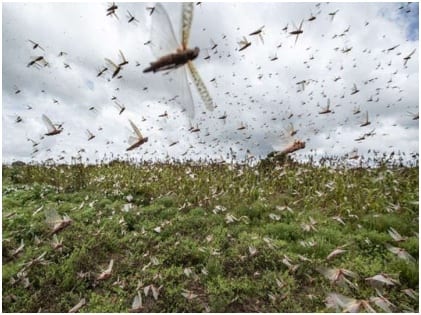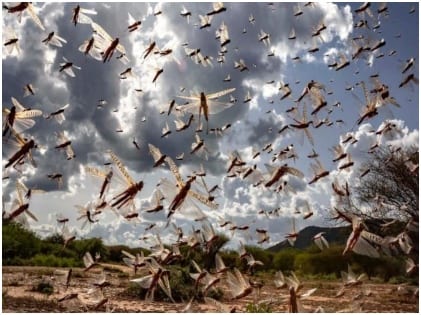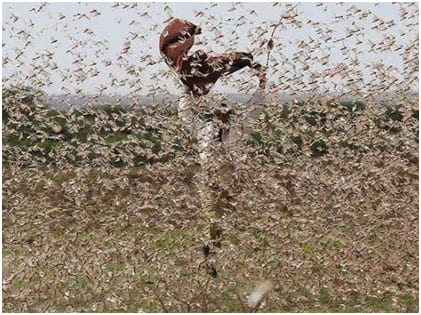Locusts, a type of grasshopper, descended upon the territory of East Africa back in January. However, by the month of February, the entire Kenyan lakeshore was completely blanked by a swarm that buzzed into the area. The insects were feasting on the region into yellow fields. Much time has passed after that, but the outbreak is practically far from being over. According to the United Nations, the situation has been alarming as food security and the livelihood of the inhabitants in East Africa are under threat owing to this unprecedented attack. However, this seems just the beginning of a very long horror story.
What Are Locusts Capable Of?
 The grasshopper species can gorge on more food than 35,000 people can consume in a single day. The insects thrive in remote areas that cover an area of 6 million square miles. Therefore, the task of putting an end to this menace is no less than daunting.
The grasshopper species can gorge on more food than 35,000 people can consume in a single day. The insects thrive in remote areas that cover an area of 6 million square miles. Therefore, the task of putting an end to this menace is no less than daunting.
However, locust experts are trying to predict the movement of this swarm and which region will it head to next, thereby issuing a warning to the inhabitants about the imminent danger. They are asking people to stay ready with insecticides. Wiping these insects out completely is not possible in the current scenario. That’s because it requires a vigorous effort from humans, and proper environmental conditions.
They Have Already Invaded South Asia
The curtain for the next scene opens in the state of Rajasthan, India. It’s the month of May, and a farmer stands helplessly, staring at his field covered with cumin plants being invaded by the swarm. The land thrived with mustard, chickpea, and cumin plants just four to five months back, and now, nearly everything has been destroyed by the insects in a matter of just twenty minutes.
Locusts don’t eat in the shade and, therefore, have spared the small bushes lying under a large tree. Ummed Singh, the owner of the land, lives near Rajasthan’s Jaisalmer and has a family of five to feed. Jaisalmer is the last outpost before the international border with Pakistan starts. He is now facing a disaster given the proximity of his land to the locust outburst zone.
What Caused The Locust Invasion?
 Scientists reveal that climate change might have brought around this outbreak, which is now uncontrollable. Taking the reports of 2019 into account, eight cyclones had developed in the western region of the mighty Indian Ocean. That triggered heavy rains that drenched the farmlands. In the past years, the region witnessed just one cyclone or maybe none. The breeding of these insects has a direct connection with food availability and moisture of the soil.
Scientists reveal that climate change might have brought around this outbreak, which is now uncontrollable. Taking the reports of 2019 into account, eight cyclones had developed in the western region of the mighty Indian Ocean. That triggered heavy rains that drenched the farmlands. In the past years, the region witnessed just one cyclone or maybe none. The breeding of these insects has a direct connection with food availability and moisture of the soil.
This implies that rain patterns pretty strongly influence locust populations. The government officials and the experts believe that the countries in the south Asian region, particularly India and Pakistan, have to join hands to combat the threat and minimize the damage. At the same time, the two countries have to make joint efforts in controlling future swarms as well. Else, the loss would be unfathomable for both the nations.
Forcing India And Pakistan To Work Together
 According to experts, the insects are a threat to people living in both India and Pakistan. Currently, both the countries are ready to keep their differences aside and fight this locus menace together. According to a few reliable, sources there have been some cross-border conflicts taking place in the region. And this can prove to be deadly for food security and economies of both the countries too.
According to experts, the insects are a threat to people living in both India and Pakistan. Currently, both the countries are ready to keep their differences aside and fight this locus menace together. According to a few reliable, sources there have been some cross-border conflicts taking place in the region. And this can prove to be deadly for food security and economies of both the countries too.
In case conflict breaks out, the FAO or the Food and Agricultural Organization of the United Nations can fulfill its responsibilities as a broker who is not in support of either side. Back in the year 1979, there was a similar locust management co-operation going on between Iran and Pakistan. Unfortunately, the Iran Revolution has disrupted all the progress the two countries had made by then. It was 1990 when both Iran and Pakistan appealed to the FAO to re-initiate the dialogue between them.
Thousands of farmers like Ummed will now have to start from scratch. The disaster has taken a toll on crops and vegetation in South Asia. It is a new kind of challenge that the farmers of the region need to face now.




